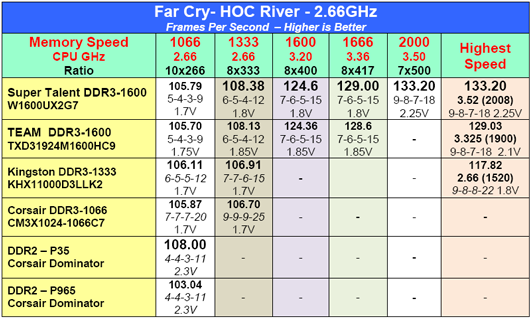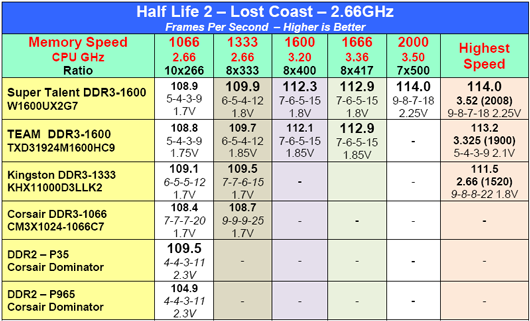Super Talent & TEAM: DDR3-1600 Is Here!
by Wesley Fink on July 20, 2007 11:30 AM EST- Posted in
- Memory
Gaming
Three DX9 games representing different gaming engines were used to test the performance of the Super Talent DDR3-1600C7 and the TEAM Xtreem DDR3-1600 in real world gaming. There are more recent gaming titles available, but they are also DX9. We will update games in the memory test suite as soon as a selection of DX10 games with reliable benchmarks is available. At that time the memory test OS will also be moved to Vista.
The Far Cry - River demo was run for 3 loops and results in FPS were averaged over the 3 runs.
Super Talent and TEAM dominate overall gaming performance of Far Cry and top the charts from 1333 to 2000+ memory speeds. Far Cry performs slightly better at 1066 with fast DDR2 memory on the P35 chipset, much as we expected.
Quake 4 and the underlying engine have always proved to be very sensitive to improvements in memory bandwidth. This is amply demonstrated in these memory tests. Again in all cases DDR2 and DDR3 are faster on P35 than the fastest DDR2 on P965. The pattern is the same as in Far Cry but the differences are magnified in Q4. The lower latencies of the new Micron Z9 DIMMs move that DDR3 to the top at 1333, and at every speed above it. It would be very interesting here if the CPU speed could be held constant and only the memory speed varied, but available ratios and the 333 multiplier make that all but impossible. What we need are 1600, 1666, and 2000 ratios available on upcoming motherboards - in addition to the 1333, 1066, 1000, and 800 that are already available.
We include Half-Life 2: Lost Coast as a representative of games that are less sensitive to improvements in memory bandwidth. Lost Coast is played through the Steam engine, where there is the constant worry, for a reviewer, that each new update of Steam will break your test benchmarks. Though the differences are very subtle and HL2 performance is most influenced by the video card used in the benchmark, there are nonetheless patterns that are exactly the same as the other two games. All P35 results are faster than the same fast DDR2 results on P965. DDR2 on the P35 is slightly faster at 1066 and the new Z9 DDR3 is tops in results at DDR3-1333 and higher.
The Super Talent and TEAM results are very close at all speeds, but Super Talent manages to be ever so slightly faster at every speed in every benchmark. Since the base memory chips are the same, a slight alteration in binning or small changes to programming the SPD could bring the Super Talent and TEAM into parity or move TEAM to the lead.
Three DX9 games representing different gaming engines were used to test the performance of the Super Talent DDR3-1600C7 and the TEAM Xtreem DDR3-1600 in real world gaming. There are more recent gaming titles available, but they are also DX9. We will update games in the memory test suite as soon as a selection of DX10 games with reliable benchmarks is available. At that time the memory test OS will also be moved to Vista.
The Far Cry - River demo was run for 3 loops and results in FPS were averaged over the 3 runs.
 |
| Click to enlarge |
Super Talent and TEAM dominate overall gaming performance of Far Cry and top the charts from 1333 to 2000+ memory speeds. Far Cry performs slightly better at 1066 with fast DDR2 memory on the P35 chipset, much as we expected.
 |
| Click to enlarge |
Quake 4 and the underlying engine have always proved to be very sensitive to improvements in memory bandwidth. This is amply demonstrated in these memory tests. Again in all cases DDR2 and DDR3 are faster on P35 than the fastest DDR2 on P965. The pattern is the same as in Far Cry but the differences are magnified in Q4. The lower latencies of the new Micron Z9 DIMMs move that DDR3 to the top at 1333, and at every speed above it. It would be very interesting here if the CPU speed could be held constant and only the memory speed varied, but available ratios and the 333 multiplier make that all but impossible. What we need are 1600, 1666, and 2000 ratios available on upcoming motherboards - in addition to the 1333, 1066, 1000, and 800 that are already available.
 |
| Click to enlarge |
We include Half-Life 2: Lost Coast as a representative of games that are less sensitive to improvements in memory bandwidth. Lost Coast is played through the Steam engine, where there is the constant worry, for a reviewer, that each new update of Steam will break your test benchmarks. Though the differences are very subtle and HL2 performance is most influenced by the video card used in the benchmark, there are nonetheless patterns that are exactly the same as the other two games. All P35 results are faster than the same fast DDR2 results on P965. DDR2 on the P35 is slightly faster at 1066 and the new Z9 DDR3 is tops in results at DDR3-1333 and higher.
The Super Talent and TEAM results are very close at all speeds, but Super Talent manages to be ever so slightly faster at every speed in every benchmark. Since the base memory chips are the same, a slight alteration in binning or small changes to programming the SPD could bring the Super Talent and TEAM into parity or move TEAM to the lead.










31 Comments
View All Comments
Wesley Fink - Friday, July 20, 2007 - link
1333 and 1066 are both at 2.66GHz - which was the best we could do. We would definitely prefer to compare ALL memory speeds at the same CPU frequency as we have done in all memory testing in the past. However, as we point out in the article, with just a 1333 strap and a 333 multiplier it just isn't possible. With boards with 1600.166 and possibly 2000 atraps we can do fixed CPU speed and varied memory speed again.Suggestions for test speeds are welcomed.
rjm55 - Friday, July 20, 2007 - link
I can see where a 1600 strap is now almost a must on motherboards with these new 1600 kits. Does anyone know of ANY Intel P35 motherboard that has support for the 1600 or 1666 strap?LTG - Friday, July 20, 2007 - link
Please cite an example of "break though performance".
It seems any benchmark gains were largely due to CPU speed differences.
Wesley Fink - Friday, July 20, 2007 - link
I consider almost doubling memory speed in less than 2 months qualifies as breakthrough, just as a 6 GHz CPU would be a breakthrough. It is true that memory is just one component in overall performance and that the impact of doubling memory speed is definitely not the same as doubling CPU speed or doubling video speed would be. That still does not change the fact that the Z9 chips are a significant memory development.It is also true that potential gains are dampened by the current lack of straps above 1333 for DDR3. However, those will come sooner, rather than later, now that memory exists that can run at 1600/1666 and 2000.
LTG - Friday, July 20, 2007 - link
Well, you still didn't answer the question so I'll repeat:Whats one single example of "breakthrough performance" provided by this memory?
Wait, let's make it easier - shouldn't the article provide any examples of significant performance differences at the same CPU speed (aside from artificial benchmarks)?
bryanW1995 - Friday, July 20, 2007 - link
A 50% increase in memory speed is not "breakthrough"? This is enthusiast/overclocking memory, it's not designed for the wannabe. Which one are you?DigitalFreak - Friday, July 20, 2007 - link
It's not when there is only a minuscule real world performance increase. It's the same situation as the P4 clock speed crap. The P4 may have run at 3.6Ghz, but it was still bested by an A64 running a Ghz or more slower.TA152H - Saturday, July 21, 2007 - link
The fallacy with your argument is that the tests presented do not include every "real world" situation (no amount of tests could), and there will be situations where the extra memory performance will exhibit extraordinary improvements, depending on the software. I was not crazy about their choice of operating systems either, and you would expect the memory difference to be more in Vista than in XP, simply because Vista uses more memory and resources, and should have a lower cache hit percentage.It's also useful within a hardware context too, not everyone will be buying a Core 2 with 4 MB cache. Right now, yes, it will be what most people get, but when AMD goes to DDR3, and DDR3 prices drop so it becomes mainstream, it will be used on systems with a smaller cache and you'll see a better improvement in speed. So, it's informative.
Also consider that DDR3 does all this with lower voltages than DDR2, so is meaningful in a performance/watt criteria.
If all you are walking away with is a 2.5% improvement with a huge increase in cost, that's not much of interest because it's not worth it for most people. But, extrapolate from that in terms of different hardware and software, and the incredible changes in DDR3 performance lately, as well as the inevitable price drops, and you might get more value out of the review.
DDR2 is obsolete. I said it a month ago, and I'm saying it again. It's low cost, but the performance is not there. It is fading fast (even faster than I thought, to be honest). In less than a month it went from being very competitive in performance and much lower cost against a technology that was showing potential but little real world current value, to already being a low cost, low performance alternative. It is not power efficient either, so all that remains to happen for DDR3 is for the price points to drop. Obviously, the performance delta will increase, but it's already better at that. Reviews like this are useful in that they show this to be true and they will give you a way to plan your next system, or perhaps put off a system purchase until a better time.
Would you buy a DDR2 based system now? It would be like buying a DX9 based video card. Why buy obsolescence when already the next generation is showing real improvements. Time will make the differences greater.
strikeback03 - Monday, July 23, 2007 - link
Speaking of voltage, no complaints over the 2.25V they used with the Super Talent DDR3? You complained about 1.7 volts in the Kingston article after all.And the comparison with DX9 video cards is not a great once for making your point either, as you already know that most people who comment here disagree with you on that point as well.
domski - Saturday, July 21, 2007 - link
Do you have any real-world power consumption figures to back up these assertions?
Don't get me wrong -- I believe you. But I would be interested to see the magnitude of the difference in both absolute power consumption and performance per watt.